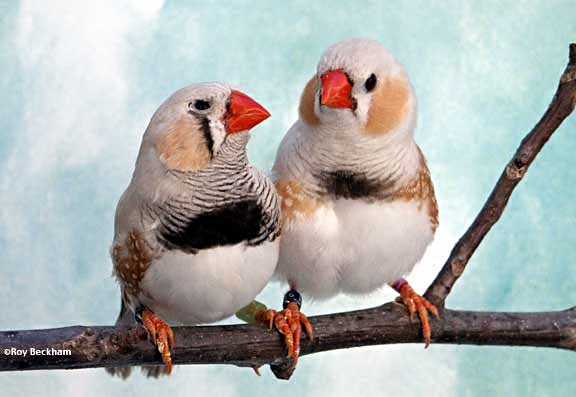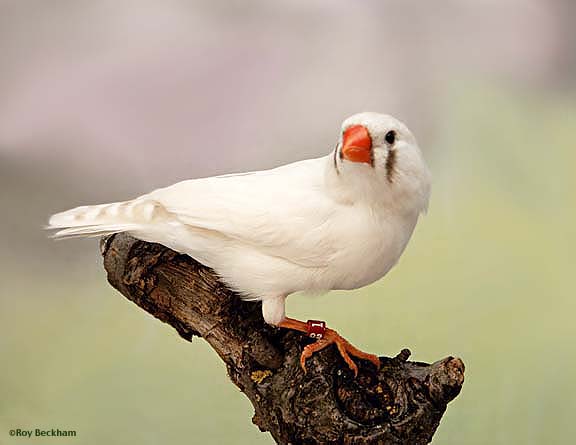




 |
|
|||||||||||||||||||||
 |
|
|
|
|
|
|
|
|
|
|||||||||||||
|
|
|
|
|
|
||||||||||||||||||
|
|
|
|
|
|
|
|
|
|
||||||||||||||
|
|
|
|
|
|
||||||||||||||||||
|
|
|
|
|
|
|
|
|
|
||||||||||||||
|
|
|
|
|
|
||||||||||||||||||
|
|
|
|
|
|
|
 |
|
|||||||||||||||
 |
 |
|
||||||||||||||||||||
|
|
|
|
||||||||||||||||||||
|
|
|
|
|
|
|
|
|
|
|
|
|
|
|
|
|
|
|
|
|
|
|
|
| Chestnut Flanked White (CFW) Zebra Finch | ||||
 |
||||
| CFW males - Continental variety (left) Regular variety (right) | ||||
|
Mutation Effects Regular CFW (Also known as old type, Black eyed or UK CFW. Formally known as Marked White) Female: Like the males, the females will have a white body with dark tear marks under the eyes. The tail will also be a diluted gray. Females often have more black flecking on the top of the head than do males. (click to view a Reg. CFW female) Fledglings: The chicks, unlike most dilute varieties, do not show any change in body or beak color. They are dark bodied with black beaks. They can be identified as soon as the white pin feathers of the wings start to show. Young females tend to carry more dark feathering on their heads than the males and can be identified early. Continental CFW (Also known as new type or red eyed CFW) Female: Like the male, female Continental CFWs are similar to their Regular counterparts, but have a cream back, black tail bars and red eyes. The Continental CFW females are also free of any black flecking on the head. (click to view a Continental CFW female) Fledglings: Continental CFW chicks are easily identified in the nest. They have pink skin and bright pink eyes. The mouth is nearly totally void of the normal mouth markings (see mouth markings).
Identifying Splits Gray males that are split for CFW (either variety) can sometimes be identified by a slight white lacing on the leading edge of some wing feathers. (click to see a Gray/CFW male) Female: Can not be split for a sex-linked mutation. Furthermore, females are either Regular or Continental CFW, they cannot carry both genes. Combinations The combination with fawn requires a genetic phenomenon known as crossing over to occur before CFW and Fawn can be combined. Crossing over is a random occurrence so one cannot predict how long, if ever, before the combination will occur. Fawn-CFWs look similar to gray series CFWs, but all the black markings will be dark brown instead. Once combined the two mutations are linked and will act as one. Some sources have erroneously indicated that the Continental CFW was a combination of CFW and Fawn. This error is probably due to a belief that the cream cast to the back was caused by the Fawn mutation rather than the new mutation. There is also some evidence that points to a modifier gene that causes a cream cast to the back of Regular CFWs that is more commonly seen in CFW-Fawns. Again, this should not be confused with the Continental CFW mutation. Both varieties of CFW can be combined with many other mutations with various degrees of attractiveness. Those that come to mind first are those mutations that alter the male markings in some way. Most fall short or the desired effect however and require that you have really strong and well marked CFWs to begin with. Often, CFWs are combined with Black Cheeks with the idea of producing a white bird with black markings. Sine the Continental variety shows stronger black markings, it may be a better choice to use in the combination. Some do not like the cream back however and try the combination with Regular CFWs. Most hens show reduced cheek patches rather than full ones and males that do show full cheeks often have orange flanks rather than black. The combination also produces gray rather than stark black markings as well. Still, they are very attractive birds when all the markings show as the breeder would like. The same line of thinking is also true for the Black Face mutation. Black Face males would show the black in front of the tear marks and the black extension of the breast bar. Like the combination with Black Cheek, the black is really a dark gray. Females would be difficult if not impossible to identify visually since the BF mutation has little effect on them. The combination with the Black Breasted mutation is also attractive since the enlarged markings of the male can be seen on the white base. The females resemble White Zebras, but can be identified by the black mark near the base of the beak. The CFW can be combined with the Orange Breasted mutation to change the breast bar to the same color as the cheek patches. The same amount of dilution seen in the cheeks will be seen in the breast bar as well. The only way to determine the combination in the hens is a light orange tear mark and bars on the tail. Otherwise, they are mostly white. Chestnut Flanked Whites are also quite attractive with the Yellow Beak mutation. The diluted beak and legs are quite attractive next to the white base color. Being a dilute variety that relies on the contrast of the markings to be appealing, the CFW does not combine to great advantage with the other dilute varieties. This includes the Dominant and Recessive Silvers, Florida Fancy and Fawn Cheek. Between the dilution of the body color and the further dilution of the markings, the combination loses much of the appeal of the CFW. Some breeders have combined the CFW with the Florida Fancy to create a bird that has been referred to as Red Flanks and are similar to the Florida Fancy, but lack the buff underparts and the orange markings are diluted. I personally do not find this combination attractive, but some might. Also, other mutations whos appeal is in the contrast of markings, Pied and Penguin, are best not combined with the CFW. CFW Fawns (click to view) Notes Regular CFWs often can be sexed while still in the nest. Males will have a cleaner, whiter head than the females. This does not apply to the Continental variety since they do not have the flecking on the head that the Regular variety does. There is some evidence that there are at least two modifier genes that work in combination with the CFW. One is a dilution modifier. This modifier is responsible for the dilution of the markings. This may account for why so many CFWs have such weak markings. The other is a cream back modifier. This modifier is separate from the Continental CFWs cream back though. Perhaps the Continental mutation is not effected by this modifier. These modifiers do not alter the appearance of the Gray Zebra or other mutations. It's interesting to note that the CFW is part of a growing multiple allelic series. These variations are caused by the mutation further mutating or trying to 'repair' itself. In the series now are the Regular and Continental CFW and the Lightback. There are some preliminary reports of another mutation called the Crema-ino that may prove to be part of the allelic series as well. The Chestnut Flanked White used to be known as the Marked White. The name was changed to avoid confusion with White Zebras that often show flecking on the back and were often referred to as marked Whites. Australian breeders did not change the name and still refer to the mutation by its original name. The Australians do have a new show standard for a Marked White that shows dilute markings and they call this bird a Chestnut Flanked White. Ironically, the American and European breeders are trying to develop birds with strong markings that are as bold as the normal gray while the Australians now have a show standard that allows for the dilution seen in the CFW. |

Regular CFW female
